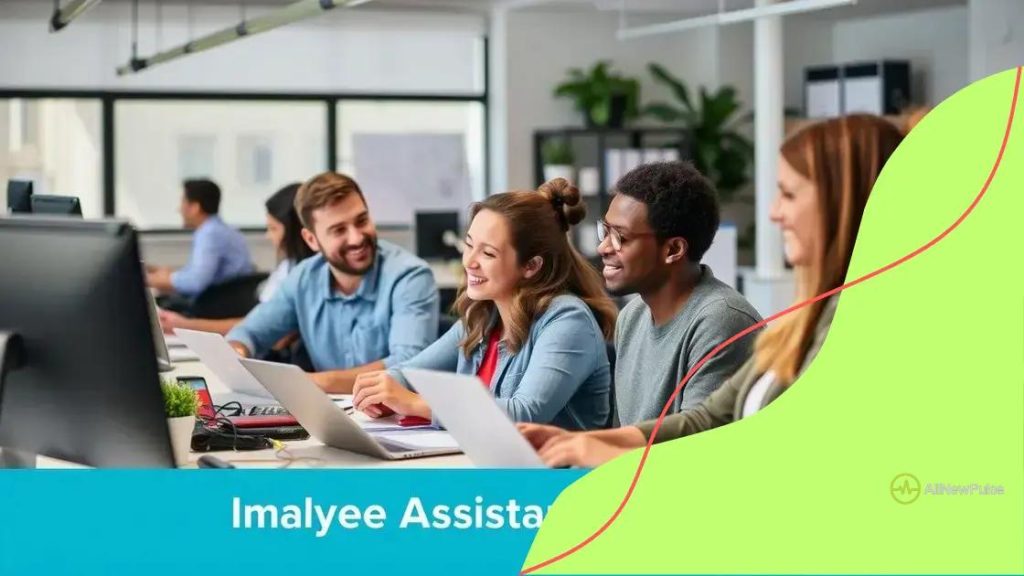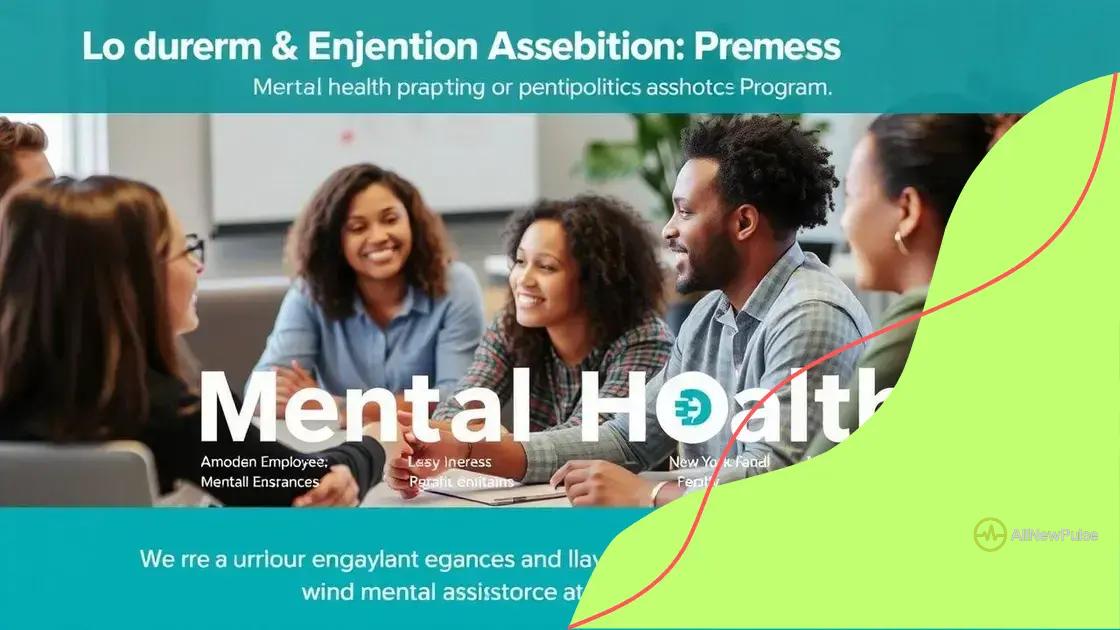The evolution of employee assistance programs (EAPs) and their impact

The evolution of employee assistance programs (EAPs) provides vital support for employees by enhancing their mental health, increasing workplace productivity, and offering diverse services, all while integrating technology for easier access.
In today’s workplace, the evolution of employee assistance programs (EAPs) plays a crucial role in supporting mental health and well-being. Have you ever wondered how these programs have changed and what they offer? Let’s dive in!
What are employee assistance programs (EAPs)?
Employee Assistance Programs, commonly known as EAPs, serve as a vital support system for employees facing personal or work-related challenges. Understanding what EAPs are can make a significant difference in employee well-being and productivity.
An employee assistance program typically offers a range of confidential services aimed at addressing mental health issues, stress management, and family problems. These programs help employees navigate their challenges while maintaining their work performance.
Key Features of EAPs
EAPs are designed to provide employees with the tools they need to manage life’s difficulties effectively. When implemented correctly, they can lead to substantial improvements in workplace morale.
- Confidential counseling services
- Workshops and training on stress management
- Support for substance abuse and mental health
- Access to legal and financial advice
Another important aspect is the accessibility of EAP services. Many programs are available 24/7 to ensure that employees can reach out for help whenever they need it. This flexibility encourages more employees to take advantage of the resources offered.
Not only do EAPs support employees, but they also provide significant benefits for employers. By fostering a healthier work environment, these programs can reduce absenteeism and improve overall job satisfaction.
Understanding employee assistance programs is crucial in today’s fast-paced work environment. They not only help individuals deal with challenges but also enhance the workplace community, paving the way for a more positive organizational culture.
The history of EAPs: From basic support to comprehensive care
The history of Employee Assistance Programs (EAPs) reveals their evolution from basic support systems to comprehensive care solutions. These programs began in the 1940s, initially focusing on helping employees with alcohol and substance abuse issues.
Over the decades, as workplace dynamics changed, so did the services offered by EAPs. The need for mental health support and personal counseling became increasingly evident, prompting a broader scope of services.
Evolution of EAP Services
In the 1980s and 1990s, EAPs expanded significantly. Employers recognized that mental health plays a crucial role in employee performance.
- Introduction of wellness programs
- Access to legal and financial counseling
- Work-life balance support
- Enhanced focus on mental health awareness
Today, EAPs encompass a wide range of services tailored to meet diverse employee needs. They provide not only counseling for work-related stress but also resources for family issues, legal problems, and health concerns. This comprehensive approach ensures that employees can access the support they need when they need it.
As organizations strive to create healthier work environments, understanding the history of EAPs is essential. Their growth reflects a cultural shift towards prioritizing employee well-being and recognizing that a supportive workplace benefits everyone involved.
Key services offered by modern EAPs

Modern Employee Assistance Programs (EAPs) offer a wide array of services designed to support the mental, emotional, and physical well-being of employees. These services have evolved to meet the diverse needs of today’s workforce.
One of the primary functions of EAPs is to provide confidential counseling services. Employees facing personal challenges can access support without fear of judgment. This fosters a safe environment that encourages workers to seek help when they need it.
Comprehensive Services
Many EAPs also include various resources aimed at enhancing employee well-being. The following services are commonly offered:
- 24/7 crisis support
- Work-life balance programs
- Workshops on stress management
- Legal and financial counseling
Additionally, some EAPs provide health resources, such as nutrition counseling and fitness programs. By promoting a healthy lifestyle, these programs help employees manage stress and maintain overall wellness.
Another essential service is training for managers and team leaders. These sessions focus on identifying signs of stress and mental health challenges among employees. Educating leaders on these topics can create a more supportive workplace culture.
Modern EAPs prioritize flexibility and accessibility, often offering virtual sessions and mobile apps. This approach ensures that employees can reach out for help whenever they need it, regardless of their location.
How EAPs benefit both employees and employers
Employee Assistance Programs (EAPs) provide a range of benefits that positively impact both employees and employers. Understanding these mutual advantages can encourage more organizations to implement such programs.
For employees, the most significant advantage is access to confidential support services. When workers face personal challenges, being able to seek help without fear of stigma can lead to improved mental health. This support means employees can address issues such as stress, anxiety, or family problems before they affect their work performance.
Employee Benefits
Moreover, access to EAPs can increase job satisfaction and morale. When employees know that their employer cares about their well-being, they are more likely to feel valued and engaged.
- Improved mental health and wellness
- Increased job satisfaction and morale
- Support for work-life balance
- Enhanced coping skills for personal and professional challenges
For employers, the benefits of offering EAPs are equally important. Organizations often see a reduction in absenteeism when employees can manage their issues effectively. Additionally, EAPs contribute to a healthier work environment and foster a culture of support and understanding.
Another advantage is the reduction of healthcare costs. When employees utilize EAP services, they are less likely to depend on emergency care for mental health crises. This proactive approach can save organizations significant money in healthcare expenses.
By investing in EAPs, employers not only enhance the well-being of their workforce but also create a more productive and positive work atmosphere. This holistic support system leads to lower turnover rates and builds a stronger company culture.
Future trends in employee assistance programs
The future of Employee Assistance Programs (EAPs) is poised for significant transformation as workplaces evolve. Emerging trends indicate a shift towards more personalized and integrated services that cater to diverse employee needs.
One major trend is the increased use of technology. EAPs are adopting digital platforms to offer virtual counseling and support. This shift makes accessing help easier for employees, particularly in remote or hybrid work environments.
Enhanced Accessibility
As technology advances, more EAPs will incorporate mobile apps and online resources. These tools provide instant access to services such as live chats, webinars, and helpful resources for mental health and wellness.
- Teletherapy services expanding in popularity
- Mobile apps for on-the-go support
- Increased use of AI for personalized mental health resources
- Online workshops and training available anytime
Another trend is the emphasis on holistic wellness. Modern EAPs are recognizing that mental health is interconnected with physical, emotional, and financial wellness. Therefore, they are expanding services to include comprehensive wellness programs.
Moreover, a growing focus on diversity and inclusion is shaping EAP offerings. Programs are evolving to ensure they cater to employees from various backgrounds, considering cultural differences and unique challenges faced by different groups. This inclusivity will enhance the effectiveness of EAP interventions.
In summary, the future trends in employee assistance programs highlight the importance of accessibility, technology integration, and comprehensive wellness. As organizations adapt, EAPs will continue to play a vital role in supporting their most valuable asset—their employees.
Employee Assistance Programs (EAPs) are essential for promoting a healthy work-life balance. As we have seen, these programs offer vital support to employees facing various challenges, ultimately enhancing workplace productivity. With the integration of technology and a focus on holistic wellness, EAPs will continue to evolve to meet the needs of employees. Organizations that invest in these resources foster a supportive culture, which benefits everyone involved.
Here’s a summary of the key points:
FAQ – Frequently Asked Questions about Employee Assistance Programs (EAPs)
What is the main purpose of Employee Assistance Programs?
The main purpose of EAPs is to provide employees with confidential support for personal or work-related challenges, enhancing their mental health and well-being.
How can EAPs benefit employers?
EAPs can benefit employers by reducing absenteeism, increasing job satisfaction, and fostering a healthier workplace culture, which can lead to increased productivity.
What types of services do modern EAPs offer?
Modern EAPs offer services such as confidential counseling, stress management workshops, legal and financial advice, and wellness programs.
How is technology changing Employee Assistance Programs?
Technology is changing EAPs by providing digital platforms for virtual counseling, mobile apps for easy access, and online resources that offer support anytime.





